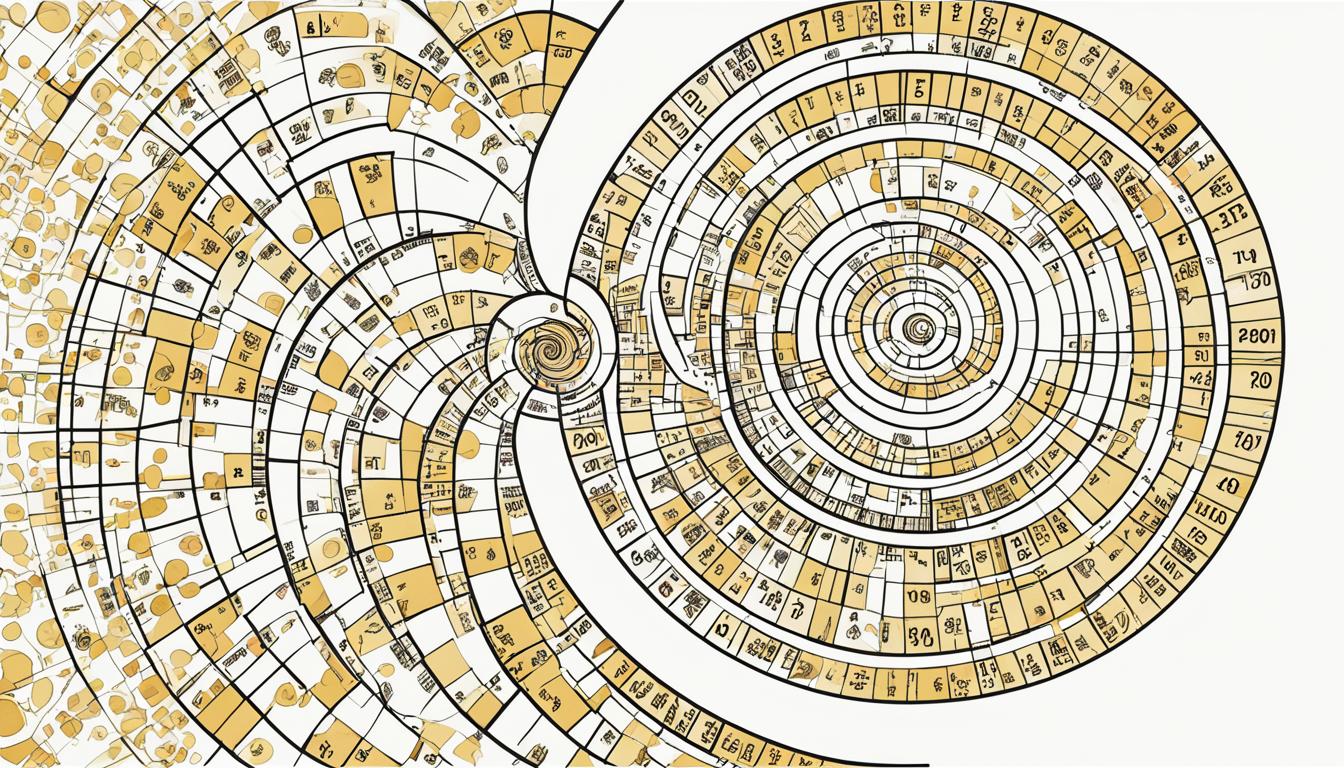Unlock the mysteries of golden zone Fibonacci usage in financial markets with this insightful exploration into one of the most fascinating elements of technical analysis. Traders worldwide scour charts for the illustrious Fibonacci levels, particularly the golden ratio, seeking to capitalize on potential price retracement opportunities. These crucial intervals, known as the fibonacci golden zone or fib golden zone, are not just academic concepts but practical tools for devising sophisticated trading strategies.
Deriving from the profound Fibonacci sequence, these Fibonacci retracement and Fibonacci extension levels embody more than just numbers—they are a confluence of ratios that have proven their significance in market trend analysis. Embark on a journey to demystify these potent technical tools and learn how identifying the Fibonacci golden zone can sharpen your trade entries, exits, and risk management tactics.
Understanding the Fibonacci Golden Zone in Technical Analysis
In the realm of financial trading, the Fibonacci Golden Zone is pivotal, frequently serving as a guiding beacon within the vast sea of technical analysis. By harnessing the predictive power of price retracement levels, particularly the 61.8% and 50% marks, traders employ the Golden Zone to navigate through significant market movements. These specific Fibonacci levels embody potential thresholds where a market’s momentum may pause or reverse, marking areas of considerable interest for both novice and seasoned traders.
When applied to the chart of an asset, these Fibonacci lines emerge as formidable support and resistance levels, influencing the decisions surrounding entry and exit positions. They are not mere abstract concepts but rather essential components of sophisticated trading strategies, enabling practitioners to decipher the language of the markets with sharper clarity.
A comprehensive understanding of the Fibonacci Golden Zone is indispensable for those looking to capitalize on its predictive capabilities. Knowledge of when prices reach these key zones allows traders to make calculated hypotheses about future price movement, thereby optimizing trade entries and exits. Additionally, this insight is instrumental in formulating strategic initiatives for setting up target prices and delineating prudent risk management measures through stop-loss orders.
Beyond the theoretical underpinnings, the practicality of using the Golden Zone emerges in its ability to inform decisions that can define the boundary between profit and loss. By attuning to these nuanced indicators of market behavior, the Fibonacci Golden Zone becomes an indispensable asset in a trader’s analytical arsenal, contributing to the refinement of strategies and enhancement of overall market acumen.
- Determination of support and resistance levels within market trends
- Enhancement of price retracement forecasting accuracy
- Defining strategic trade execution points
- Risk management through informed stop-loss placements
In applying this knowledge to real-world scenarios, traders develop a keener sense of market timings, becoming proficient in distinguishing routine price fluctuations from those indicative of a more substantial shift. Thus, the Fibonacci Golden Zone is a cornerstone of technical analysis, granting traders an additional layer of insight in the ever-evolving landscape of financial markets.
Applying Golden Zone Fibonacci in Modern Trading
The art of trading is ever-evolving, but certain strategies stand the test of time due to their robustness and reliability in market analysis. One such enduring method is the application of the Fibonacci Golden Zone strategy, which integrates traditional trading principles with cutting-edge technical analysis to forecast market movements effectively.
Drawing Fibonacci Retracement Levels Accurately
Accurate drawing of Fibonacci retracement levels is a foundational aspect of the Fibonacci Golden Zone strategy. Identifying precise high and low points from significant market movements ensures the credible implementation of the Fibonacci tools and paves the way for the identification of the Golden Zone. It is in this zone—at the strategic 61.8% and 50% retracement levels—where traders often expect potential reversals in price, steering their decisions in market execution.
Identifying High-Probability Trade Setups
Finding high-probability trade setups requires more than a cursory glance at a chart. By coupling the Fibonacci Golden Zone with other technical indicators such as candlestick patterns, traders can greatly increase the accuracy of their predictions. It is the confluence of these indicators, consistently applied within the Golden Zone, that highlights the most probable trading opportunities, integral for risk management and effective trading.
Combining Fibonacci with Other Trading Indicators
While the Golden Zone serves as a critical component for identifying potential trend reversals, its potency is significantly enhanced when synergized with other technical indicators. These include moving averages, relative strength index (RSI), and MACD—each offering additional insights into the market’s direction. The integrated approach, which complements Fibonacci retracement with these technical tools, provides a comprehensive framework for traders to make informed decisions that align with the core tenets of risk management and disciplined trading.
The Mathematical Foundation of the Fibonacci Sequence
The Fibonacci sequence is not just a series of numbers that appear randomly; it represents a pattern that underlies some of the fundamental structures in our universe. Discovered by Leonardo Fibonacci, the sequence provides a remarkable insight into the mathematical relationships that are prevalent in various forms of life and phenomena. Notably, the golden ratio, approximately 1.618, is a critical component that arises from these numerical sequences.
From pinecones to galaxies, the golden ratio and the Fibonacci numbers are omnipresent, influencing the way we perceive balance and aesthetics in nature and art. Moreover, these ratios are integral in the financial world, offering traders a tool to peer through the veil of price charts and predict movements with a surprising degree of accuracy.
- The sequence begins with 0 and 1, and each subsequent number is the sum of the previous two.
- The ratio between consecutive Fibonacci numbers approximates the golden ratio as the numbers increase.
- This mathematical relationship helps traders identify potential levels of support and resistance on the charts.
- Key Fibonacci ratios include 23.6%, 38.2%, and the golden ratio itself at 61.8%.
These numbers are not arbitrary; they form part of a harmonious pattern observable in the very structure of our environment. In financial markets, such patterns can sometimes predict changes in market psychology, as levels derived from the Fibonacci sequence often align with human decisions and market trends.
In conclusion, the Fibonacci sequence and the golden ratio encapsulate more than mere figures on a page; they embody a principle of order and proportion that resonates with the fundamental makeup of our world. As traders harness this knowledge in the form of Fibonacci numbers on price charts, they engage with a deep-rooted mathematical legacy left by Leonardo Fibonacci himself.
Golden Zone Fibonacci Trading Strategy in Detail
Delving deeper into the Fibonacci trading strategy, we find its practical application in the currency exchange market, especially with pairs like USD/CAD. The crux of this strategy involves utilizing the Fibonacci retracement levels to signal potential trend reversals or continuations. By analyzing these key levels within the context of market trends, traders are better poised to make informed decisions. The Golden Zone, found between the 61.8% and 50% retracement levels, is where price movements are keenly watched for signs of stabilization or a shift in trajectory.
Real-Time Strategy Example Using USD/CAD Pair
The USD/CAD currency pair serves as an exemplary case for applying the Golden Zone Fibonacci strategy. Imagine the market in an uptrend; as it begins to pull back, attention focuses on the retracement reaching the Golden Zone. Should the price enter this area, this may be a cue for traders to prepare for a possible reversal. At this point, entry positions are considered, and the keen eye of the trader watches for candlestick patterns that validate the potential change in direction.
Interpreting Reversal and Continuation Signals
Interpreting signals for reversals and continuations is a pivotal component of this trading approach. Candlestick formations, beyond their traditional scope, play a complementary role in confirming whether the next move is a reversal back onto the prevailing trend or a continuation of the retracement. This dual capacity to interpret market signs fortifies the trader’s strategy, providing a more comprehensive perspective on possible market actions.
Setting Targets and Stop-Losses in Fibonacci Trading
Success in trading often comes down to the discipline of setting clear targets and stop-loss orders. A crucial aspect of risk management, the placement of these orders is informed by Fibonacci retracement levels as well as the expected risk-reward ratio. Identifying precise exit points ensures traders are primed to capture desired profits or exit the market to curb losses. Practiced calculation and strategic placement of targets and stop-losses are the cornerstones of a successful Fibonacci trading strategy.






